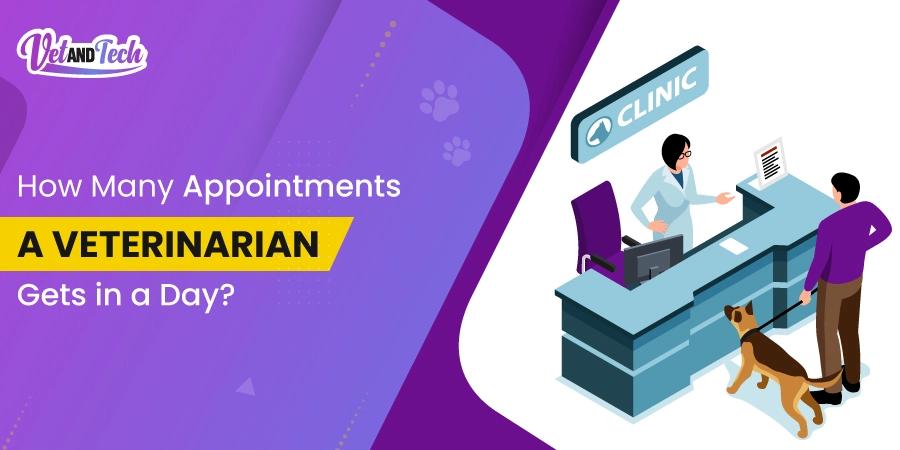How Many Appointments a Veterinarian Gets in a Day?
As veterinarians, one of the most frequently asked questions is, “How many appointments do you get in a day?”
That’s quite interesting because the number of patients per day for veterinarians varies greatly from practice to practice, depending on the clinic's location and the range of services rendered.
Here, we will discuss everything about the veterinarian's day in the clinic and specifically discuss;
- How many clients do vets get in 1 day?
- Factors that affect daily client load for veterinarians
- Routine workflow in a veterinary clinic
- How long do vet appointments take?
- Balancing between appointments and emergencies?
- Improve efficiency in veterinary practices
Average Number of Veterinary Appointments Per Day
If we rationally talk about how many clients do vets get in 1 day? Then, as per expert analysis, it typically ranges between 15 and 30.
However, other factors can influence the vet clinic's daily patient load as well:
- Type of Practice:
General practice vets, who handle a wide range of health issues, might see more patients than specialists.
- Clinic Size:
Larger clinics with multiple vets and staff may see a higher number of appointments.
- Location:
Vets in urban areas might handle more cases due to higher demand compared to rural locations.
Some days are busier than others. For instance, Mondays and Fridays are often packed as clients try to get their pets in before or after the weekend.
Factors That Affect Daily Client Load
Below are some of the leading triggers that affect the daily client load for veterinarians;
- Clinic Type
Most veterinary clinics that classify themselves as general practitioners cope with a broad caseload. These range from veterinarian fees for routine examinations to more serious cases.
In contrast, practitioners such as an oncologist or an orthopedic surgeon may have fewer but more extended appointments because of the nature of their cases. To understand more about the various veterinary specialties, read our article on Types of Vets and Their Role in Animal Healthcare.
- Appointment Duration
Different appointments can be on different time spans. A normal-weight animal clinical appointment lasts approximately a quarter of an hour and a half an hour.
But more complicated health problem appointments can be from ½ an hour to 1 hour and over.
- Routine Check-Ups: These typically take 15 minutes.
- Diagnostics: If tests or x-rays are involved, this can extend to 30 minutes or more.
- Surgical Consultations: These often take longer, as detailed discussions are required.
- Emergency Cases
There are also emergency cases that the veterinarians take care of as well, which often interfere with their appointment schedule.
Emergency cases would require immediate interventions, reducing the day's provisions of normally intended appointments.
Daily Workflow in a Veterinary Clinic
A veterinarian’s day is structured to ensure they can manage the caseload efficiently.
Here's how a typical day might unfold:
8:00 AM - 9:00 AM: Preparing for the Day
- Reviewing the Schedule
Veterinarian client appointments start by reviewing the day schedule and assessing the expected workload.
- Team Briefing
A short meeting with vet techs and assistants helps plan the day ahead. Read what vet techs do on a daily basis.
- Setting Up Equipment
Any necessary diagnostic or surgical equipment is prepped.
9:00 AM - 12:00 PM: Morning Appointments
- Routine Exams
Early appointments usually consist of wellness exams, vaccinations, and minor health concerns.
- Diagnostics
Blood tests, x-rays, and other procedures are performed as needed.
12:00 PM - 1:00 PM: Lunch and Emergencies
- Lunch Break
Often interrupted by emergency cases that come in unexpectedly.
- Emergency Cases
These require immediate attention, taking priority over regular appointments.
1:00 PM - 5:00 PM: Afternoon Appointments
- Follow-up appointments
Vets often see patients returning for follow-ups in the afternoon.
- Surgical Consultations or Minor Surgeries
These are scheduled for the latter half of the day, depending on the complexity.
How Long Do Vet Appointments Take?
The duration of the appointment may be very different depending on the issues at hand.
However, most veterinarians try to avoid this, with each session being quick and still ensuring that every pet receives the best care possible.
Below is a breakdown:
- Routine Appointments:
These take about 15-20 minutes.
For the most part, they involve regular check-ups and vaccinations.
- Diagnostic Appointments:
This may take 30-45 minutes, especially when more investigations, such as X-rays, are needed.
- Surgeries and Post-Op Consults:
These would last an hour or more in some cases, with the actual procedure dictating the time taken.
How Do Vets Balance Appointments and Emergencies?
Emergency cases are unpredictable and add pressure to an already busy schedule.
Veterinarians must be ready to drop everything to attend to emergencies, such as:
- Ingested Foreign Objects
- Severe Allergic Reactions
- Accidents or Trauma
Emergency situations are common in the line of veterinary work, and that is why a few clinics have a structure that accommodates one or two emergency cases a day.
Nevertheless, in cases where all the appointments have been booked, the slippage of an emergency case is problematic, and this modifies the regular appointment schedules.
Daily Management of Veterinary Appointments Challenges
In a day, appointment management is often subjected to various constraints by veterinarians. Some of these challenges include:
- Overbooked Schedules
There is scrutiny over the likelihood of accepting appointments where a clinic is already full of booked clients and these are termed as overbooked.
- Poor attendance/No shows:
These may be very annoying because they upset the schedule and affect the efficiency of the clinic.
- Complex Cases:
There are some instances where a case takes longer than expected, affecting other appointments.
Improving Efficiency in Veterinary Practices
To manage time more effectively, many veterinary clinics use strategies to streamline their operations. Learn how the Veterinary Clinic in Attica made headlines with the first-ever machine for laser stone crushing, showcasing innovation in veterinary care.
Appointment Scheduling Software
- Helps avoid double bookings by organizing appointments efficiently.
- Streamlines the daily schedule, optimizing the time for each consultation.
Pre-Appointment Questionnaires
- Allows the vet to prepare for the consultation in advance.
- Reduces the time spent gathering basic information during the visit.
Designated Surgery Days
- Provides a focused schedule for surgeries without interruption.
- Improves efficiency by grouping similar procedures on the same day.
Streamlined Workflow Protocols
- Ensures that all team members follow consistent procedures.
- Reduces confusion and speeds up daily tasks.
Electronic Medical Records (EMRs)
- Facilitates easy access to patient data
- Improves record-keeping accuracy, reducing paperwork errors.
Telemedicine Options
- Enables remote consultations
- Freeing up time for in-clinic visits
- Provides quick assessments for non-urgent cases
To Sum Up
If we talk honestly, how many clients do vets get in 1 day? It’s between 15-30 clients per day.
In every case, veterinarians strive to balance patient care with efficiency, ensuring every pet receives the attention it deserves while running the clinic smoothly.
If you want free veterinary education and resources, join the Vet and Tech platform. We offer productive webinars that enable you to obtain free RACE-approved CE credits. We also offer insights into career advancement. Check out Veterinary Technician Career Guide.
Furthermore, our blog and news sections provide accurate and up-to-date information on the industry, such as career and educational guidance.
FAQs
1. How long is the average veterinary appointment?
The average veterinary appointment lasts 15 to 30 minutes, depending on the type of visit. Routine exams are quicker, while more complicated cases, like diagnostics or surgical consultations, take longer.
2. Do veterinarians handle emergencies during regular appointments?
Yes, veterinarians often deal with emergencies, even during regular appointments. This can cause delays but is a crucial part of veterinary care.
3. What is the busiest time of day for veterinarians?
The busiest times are usually mid-morning to early afternoon. Most clients prefer scheduling appointments around their work hours, making these times peak clinic hours.
4. How many clients do vets get in 1 day?
The veterinarians commonly attend 15- 30 appointments per day while considering all the factors and challenges. However, these numbers can be improved by incorporating the above efficiency measures








